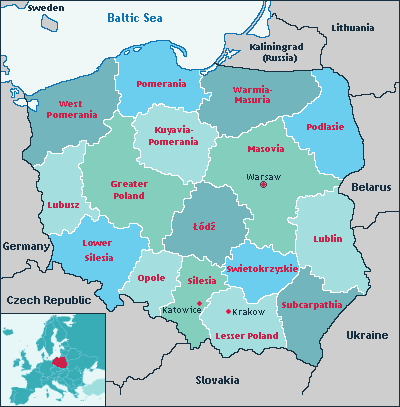Poland
In short

Administrative division
The Territory
The Population
History
Occupied by Germany in the Second World War, the country was deeply changed by the terrible war events: 3 million of the Polish Jews were killed, as well as other 3 million civilians, and after the war almost 4 million of Polish Germans were expelled and a communist regime was imposed to the country; in the following decades opposition led to the rise of the Solidarnosc trade union federation, which organised political rebellion on a massive scale ultimately bringing about the end of communism in Poland, probably also thanks to the powerful influence of Polish-born pope John Paul II. Since 1992 Poland has been a democratic republic.
Cities and places of interest
Among the most fascinating cities is the ancient Cracow, in southern Poland, today also an important industrial centre thanks to the nearby Nowa Huta productive plants. The capital of Poland until the 17th century, Cracow was largely spared from the devastation of the Second World War, whereas Warsaw was almost razed to the ground, and can therefore show a remarkable artistic heritage. The ancient town was reconstructed after the Tatars invasion of 1257 according to a regular geometrical plan. In the centre is the market, a huge square with sides 200 mt long, probably the largest medieval square all over Europe, which was full in the past of shops and street vendors. During the 19th century the shops disappeared, and only three buildings were left: the small church of St. Mary, the municipal Tower, and a huge, elegant Renaissance Lodge devoted originally to the trade of woollen cloth, which today the lodge hosts on the firs floor a Museum of Polish painting and on the ground floor dozens of craft shops selling jewels and objects made with Baltic amber.
Outside the ancient center, on a hilltop overlooking the Vistula (in Polish Wisla) river, rises the Wawel fortress, almost a symbol of the country, which was the seat of the Polish monarchy for over five centuries. Inside the fortress is the majestic Cathedral, where almost all the sovereigns were crowned and buried. Near the Cathedral is the Castle, which hosts today a number of museums. On the other bank of the Vistula is the district of Kazimierz, once separated from Cracow, where a populous Jewish community had lived for centuries, until they were exterminated by the Nazi regime, most of then deported to the famed Auschwitz camp, a few kms from here; in this district the greater part of the movie Schindler's List was filmed.
How to arrive
UNESCO World Heritage Sites

- Kraków's Historical Centre;
- the Wieliczka Salt Mine, in operation since the 13th century, one of the world's oldest operating salt mines;
- Former Nazi German Concentration Camp Auschwitz-Birkenau, near Oswiecim;
- the Biaowieza Forest, shared with Belarus, the only remaining part of the large forest which once spread covered the Central European Plain;
- the Historical Centre of Warsaw;
- Old City of Zamosc, a great example of a Renaissance town blending Italian and central European traditions;
- the Teutonic Castle of Malbork, among the most astonishing Gothic castles in Europe;
- Medieval Town of Torun, situated in Northern Poland on the Vistula river, rich of monuments and palaces in the Gothic style;
- Kalwaria Zebrzydowska, the Mannerist Architectural and Park Landscape Complex and Pilgrimage Park;
- the Lutheran Churches of Peace in Jawor and Swidnica, large timber-framed buildings;
- the many medieval Wooden Churches of Southern Little Poland, built with the the horizontal log technique;
- Park Muzakowski shared with Germany, on both sides of the Nysa River, which marks the German-Polish border, among the most famous English-style parks in central Europe and a successful example of landscape architecture, with an area of 3.5 sq km in Poland and 2.1 in Germany;
- the Centennial Hall in Wrocaw, built on a project by Max Berg in 1911-1913 for an exhibition commemorating the 100th anniversary of the Battle of Leipzig, with a huge cupola was made of reinforced concrete, an inner diameter of 69 m and 42 m high.
The Economy
As to mineral resources, in the Silesian district there are rich coal mines (Poland is 7th in the world for coal production) which allows the country to be self-sufficient energetically, coal being used to produce electricity. The main industrial sectors are the mechanic and automotive, while electronics and telecommunications are in rapid growth, as is also the tertiary sector.

